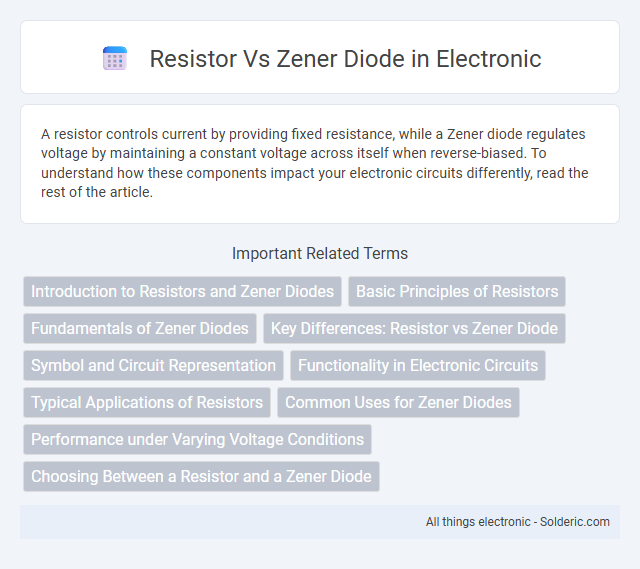A resistor controls current by providing fixed resistance, while a Zener diode regulates voltage by maintaining a constant voltage across itself when reverse-biased. To understand how these components impact your electronic circuits differently, read the rest of the article.
Comparison Table
| Feature | Resistor | Zener Diode |
|---|---|---|
| Primary Function | Limits electric current | Voltage regulation and reference |
| Operation | Obeys Ohm's Law (V=IR) | Operates in reverse breakdown region |
| Voltage Control | No voltage regulation | Maintains fixed voltage (Zener voltage) |
| Symbol | Simple zigzag line | Diode symbol with bent line and Z |
| Application | Current limiting, voltage division | Voltage stabilization, surge suppression |
| Power Dissipation | Depends on current and resistance (P=I2R) | Limited by maximum Zener current and power rating |
| Voltage Range | Varies continuously | Fixed Zener voltage (typically 2.4V to 200V) |
Introduction to Resistors and Zener Diodes
Resistors limit current flow and drop voltage in electronic circuits, providing stability and protection for components. Zener diodes regulate voltage by maintaining a constant reference voltage during reverse bias, crucial for voltage regulation and protection against voltage spikes. Your choice between these components depends on whether you need simple current control or precise voltage regulation.
Basic Principles of Resistors
Resistors regulate electrical current by providing a fixed opposition measured in ohms, enabling precise control over voltage and current in circuits. They operate on Ohm's Law, where voltage (V) equals current (I) multiplied by resistance (R), ensuring stable and predictable circuit behavior. Your electronic designs benefit from resistors by protecting components and managing signal levels efficiently without altering circuit functionality.
Fundamentals of Zener Diodes
Zener diodes are semiconductor devices designed to operate in the reverse breakdown region, maintaining a stable and precise voltage across their terminals, which makes them ideal for voltage regulation and reference applications. Unlike resistors, which provide a linear resistance to limit current, Zener diodes exploit their sharp breakdown voltage to clamp voltage levels and protect circuits from overvoltage conditions. The key parameter of a Zener diode is its Zener voltage, typically ranging from a few volts to several hundred volts, which defines the voltage at which it conducts in reverse bias without damage.
Key Differences: Resistor vs Zener Diode
A resistor limits current flow by providing constant resistance regardless of voltage, whereas a Zener diode maintains a stable voltage by allowing current to flow in reverse once a specific breakdown voltage is reached. Resistors dissipate energy as heat, making them ideal for current control, while Zener diodes serve as voltage regulators or voltage reference components in circuits. Understanding these key differences enables you to choose the appropriate component for voltage stabilization or current limiting in your electronic designs.
Symbol and Circuit Representation
The resistor symbol is represented by a simple zigzag line or a rectangle in circuit diagrams, indicating a passive component that restricts current flow. The Zener diode symbol consists of a standard diode arrow with bent edges on the bar, specifically showing its ability to conduct in the reverse breakdown region. In circuits, resistors are placed in series or parallel to control voltage and current, while Zener diodes are connected in reverse bias to regulate voltage by maintaining a constant voltage level across loads.
Functionality in Electronic Circuits
Resistors primarily control current flow and divide voltage in electronic circuits by providing a fixed resistance value, ensuring proper operation of components. Zener diodes regulate voltage by allowing current to flow in the reverse direction when a specific breakdown voltage is reached, enabling stable voltage reference and protection. While resistors dissipate power as heat, Zener diodes maintain voltage levels, crucial for voltage regulation and surge protection.
Typical Applications of Resistors
Resistors are commonly used in electronic circuits to limit current, divide voltages, and bias active components such as transistors and operational amplifiers. They play a crucial role in setting operating points and stabilizing circuit behavior by providing predictable resistance values. Typical applications include current limiting in LED circuits, creating voltage drop for sensor interfacing, and forming part of RC filters for signal conditioning.
Common Uses for Zener Diodes
Zener diodes are commonly used for voltage regulation, providing a stable reference voltage in power supplies by maintaining a constant output voltage despite fluctuations in input voltage or load conditions. They serve as voltage clamps in protecting sensitive electronics from voltage spikes and overvoltage conditions. Your circuits benefit from Zener diodes in ensuring precise voltage control and enhancing overall reliability.
Performance under Varying Voltage Conditions
Resistors maintain a consistent resistance value regardless of voltage changes, providing stable current flow but without voltage regulation capabilities. Zener diodes exhibit a sharp breakdown voltage, allowing them to regulate and stabilize voltage by maintaining a constant output voltage despite input voltage fluctuations. Under varying voltage conditions, zener diodes effectively protect circuits by clamping voltage, while resistors primarily limit current without voltage stabilization.
Choosing Between a Resistor and a Zener Diode
Choosing between a resistor and a Zener diode depends on the desired voltage regulation and current control in a circuit. A resistor is ideal for limiting current and providing voltage drop in low-precision applications, while a Zener diode offers stable voltage regulation by maintaining a constant voltage across itself under varying load conditions. For protecting sensitive components from voltage fluctuations, selecting a Zener diode is more effective due to its voltage clamping capabilities compared to the simple current limiting function of a resistor.
resistor vs zener diode Infographic

 solderic.com
solderic.com